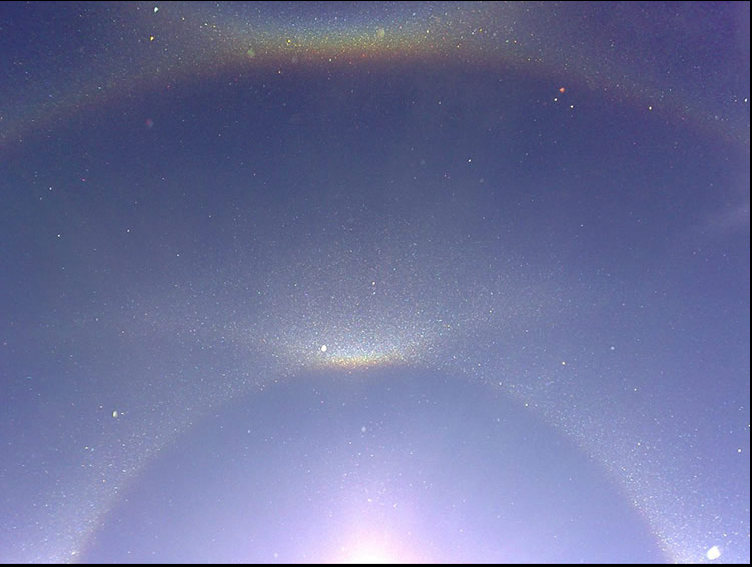Today's Feature - Diamond Dust Display
Today's Feature - Diamond Dust Display: A Mesmerizing Atmospheric Phenomenon
Diamond dust, an awe-inspiring atmospheric optics phenomenon, enchants observers with its glimmering ice crystals that swirl and dance in the cold air. While some diamond dust displays near ski resorts are artificially created by wind-blown crystals from snow machines, the spectacle captured in this image, taken by Franck Schwitter in Crans Montana, Switzerland, was completely natural, devoid of any human intervention.
At the heart of this captivating scene are several remarkable optical phenomena that occur due to the interaction of sunlight with ice crystals suspended in the atmosphere. The lower circle visible in the image is known as a 22 degree halo, a common sight formed by the refraction and reflection of sunlight by hexagonal ice crystals. Crowning the halo is a distinctive "gull's wing" upper tangent arc, caused by horizontally oriented column crystals. These same crystals contribute to the formation of a large downward curving arc at the top, known as a supralateral arc.
One of the most striking elements of this diamond dust display is the brightly colored circumzenithal arc that arcs upwards from the supralateral arc. This vivid arc owes its existence to plate crystals present in this particular atmospheric event. Unlike sundogs and 22 degree halos, which exhibit smaller face inclinations of around 60 degrees, the rays of sunlight passing through the plate crystals are refracted between crystal faces tilted at a remarkable 90 degrees to each other. As a result, the colors comprising the circumzenithal arc are spread wider apart across the sky, creating a broader and more vibrant display.
The interplay of different types of ice crystals within the diamond dust cloud contributes to the richness and complexity of the observed atmospheric optics phenomena. Each crystal shape and orientation affects how sunlight is refracted and reflected, leading to the formation of distinct arcs and halos. The intricate nature of these displays serves as a testament to the diverse and captivating interactions that can occur within our atmosphere.
It is worth noting that the image captured by Franck Schwitter and shared with permission showcases the exceptional beauty and natural elegance of diamond dust displays. However, due to the limitations of automatic conversion from the old website, the article may not appear as originally intended. For the original article, please refer to the provided link.
In summary, diamond dust displays are mesmerizing atmospheric phenomena that captivate viewers with their shimmering ice crystals. The interplay of different crystal shapes and orientations within the cloud leads to the formation of distinct halos and arcs, such as the 22 degree halo, upper tangent arc, supralateral arc, and circumzenithal arc. Each of these phenomena is a testament to the intricate and diverse interactions that occur within our atmosphere. The image captured by Franck Schwitter beautifully showcases the natural elegance of diamond dust displays, reminding us of the enchanting beauty that can be found in our everyday surroundings.

Diamond Dust Halos - Imaged by Franck Schwitter at 2000m plus in Crans Montana, Switzerland.
Diamond dust, ice crystals glinting and swirling all around in the cold air, produces some of the very finest displays. Those seen near ski resorts are often artificial, produced by wind-blown crystals from snow machines. These halos were fully natural as no machines were operating.
The lower circle is a 22 degree halo topped by a "gull's wing" upper tangent arc made by horizontal column crystals. The same crystals made the large downward curving arc at top - a supralateral arc. Touching the supralateral and curving upwards is a brightly coloured circumzenithal arc made in this display by plate crystals.
Supralateral and circumzenithal arcs are broader with more apparent colour because the rays forming them pass between crystal faces tilted 90° to each other. Compared to the smaller 60° face inclination of sundog and 22 degree rays, the colours are spread wider apart in the sky.
Image ©Franck Schwitter, shown with permission.
Note: this article has been automatically converted from the old site and may not appear as intended. You can find the original article here.
Reference Atmospheric Optics
If you use any of the definitions, information, or data presented on Atmospheric Optics, please copy the link or reference below to properly credit us as the reference source. Thank you!
-
<a href="https://atoptics.co.uk/blog/todays-feature-diamond-dust-display/">Today's Feature - Diamond Dust Display</a>
-
"Today's Feature - Diamond Dust Display". Atmospheric Optics. Accessed on November 24, 2024. https://atoptics.co.uk/blog/todays-feature-diamond-dust-display/.
-
"Today's Feature - Diamond Dust Display". Atmospheric Optics, https://atoptics.co.uk/blog/todays-feature-diamond-dust-display/. Accessed 24 November, 2024
-
Today's Feature - Diamond Dust Display. Atmospheric Optics. Retrieved from https://atoptics.co.uk/blog/todays-feature-diamond-dust-display/.